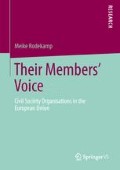Abstract
In the Discussion Paper “The Commission and Non-Governmental Organisations: Building a Stronger Partnership”, the European Commission (2000: 4) writes:
Access this chapter
Tax calculation will be finalised at checkout
Purchases are for personal use only
Notes
- 1.
The “transmission belt” functions in two ways: Aside from channelling concerns from civil society upward, CSOs also reach back down into the citizenry and channel political decisions from the institutions downward.
- 2.
Art. 10(1) and 11 TEU.
- 3.
For example, the think tank ‘One World Trust’ regularly publishes the Global Accountability Report, which monitors the accountability of CSOs (www.oneworldtrust.org/globalaccountability/gar, last accessed 16 February 2013). ‘AccountAbility’, a self-managed partnership of corporations and non-profit organisations, develops collaborative standards for social, environmental, and governance standards (www.accountability.org/index.html, last accessed 16 February 2013). The World Association of NGOs has initiated the Code of Ethics Project (www.wango.org/codeofethics.aspx, last accessed 16 February 2013). A group of large international CSOs have formulated the ‘International NGO Accountability Charter’ (www.ingoaccountabilitycharter.org, last accessed 16 February 2013). Other CSOs have subjected themselves to inner-organisational codes of conduct, which provide standards for their internal governance (Piewitt et al. 2010). Attempts to regulate CSO activism can also be found at the national level. The ‘Philippine Council for NGO certification’ is a case in point (Brown 2007).
- 4.
This term is frequently used to distinguish the dialogue with a wide range of CSOs from the “social dialogue” between EU institutions and the social partners (see Chapter 2.2.6 for details).
- 5.
This question is not a focus of the present study. It has been ensured that the CSOs subject to this analysis are those that are most likely to have influence on EU decision-making (see Chapter 3.2).
- 6.
This study’s focus is on legal persons as members for all the CSOs subject to this analysis. This is in spite of the fact that business associations bring together legal persons at the end of the representation chain, while trade unions and classical NGOs bring together natural persons at the end of the representation chain.
- 7.
For a detailed account on non-profit membership-based organisations, see Tschirhart (2006).
Author information
Authors and Affiliations
Rights and permissions
Copyright information
© 2014 Springer Fachmedien Wiesbaden
About this chapter
Cite this chapter
Rodekamp, M. (2014). Introduction. In: Their Members’ Voice. Springer VS, Wiesbaden. https://doi.org/10.1007/978-3-658-02213-6_1
Download citation
DOI: https://doi.org/10.1007/978-3-658-02213-6_1
Publisher Name: Springer VS, Wiesbaden
Print ISBN: 978-3-658-02212-9
Online ISBN: 978-3-658-02213-6
eBook Packages: Humanities, Social Sciences and LawPolitical Science and International Studies (R0)

